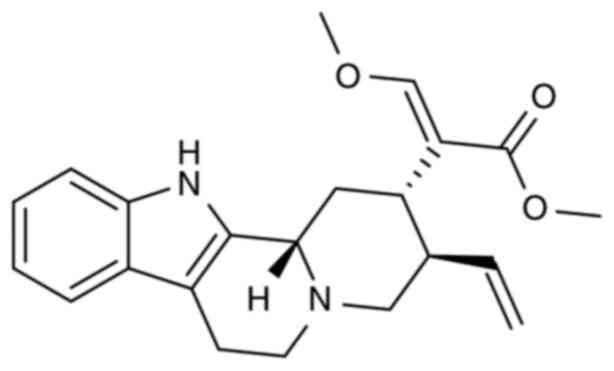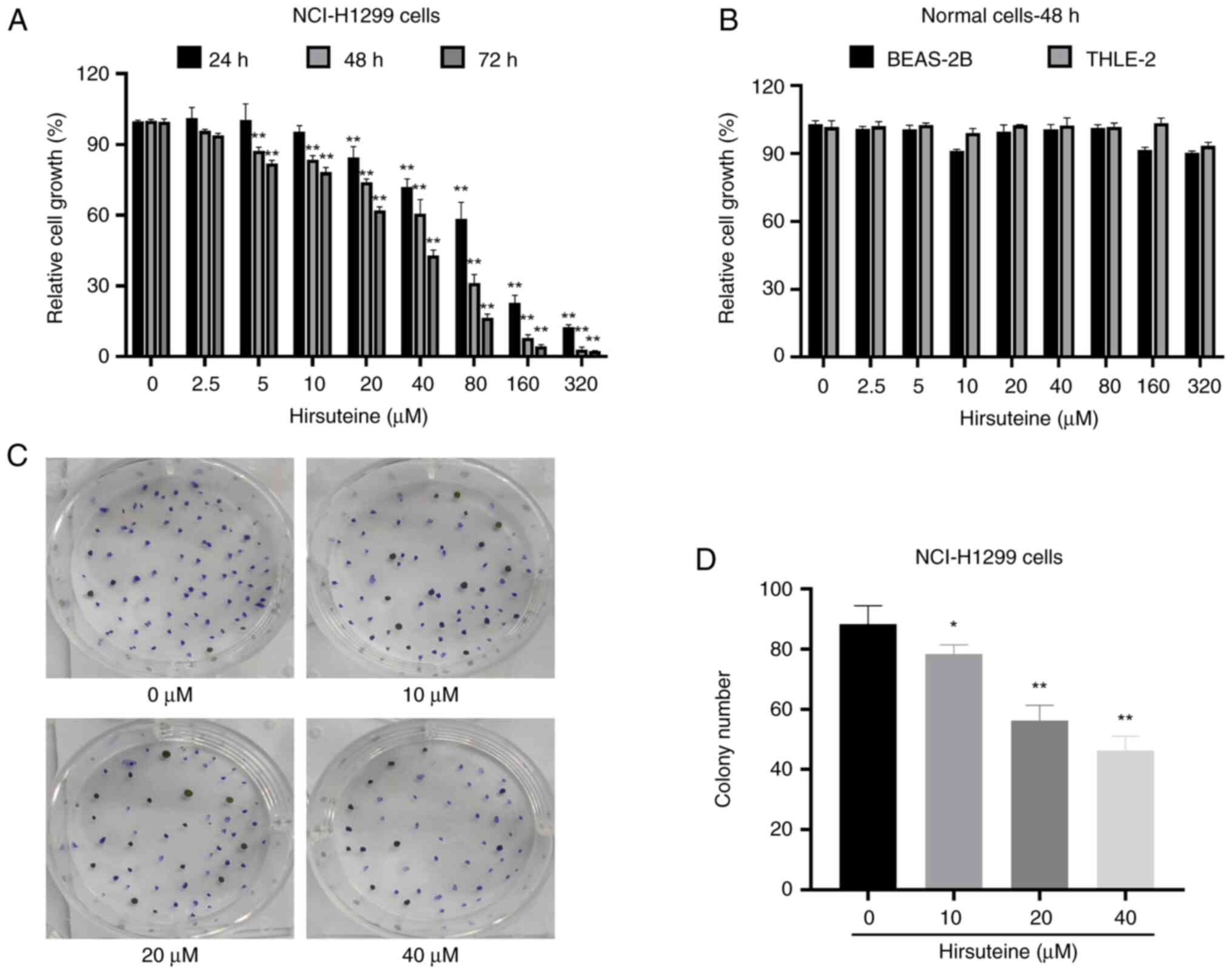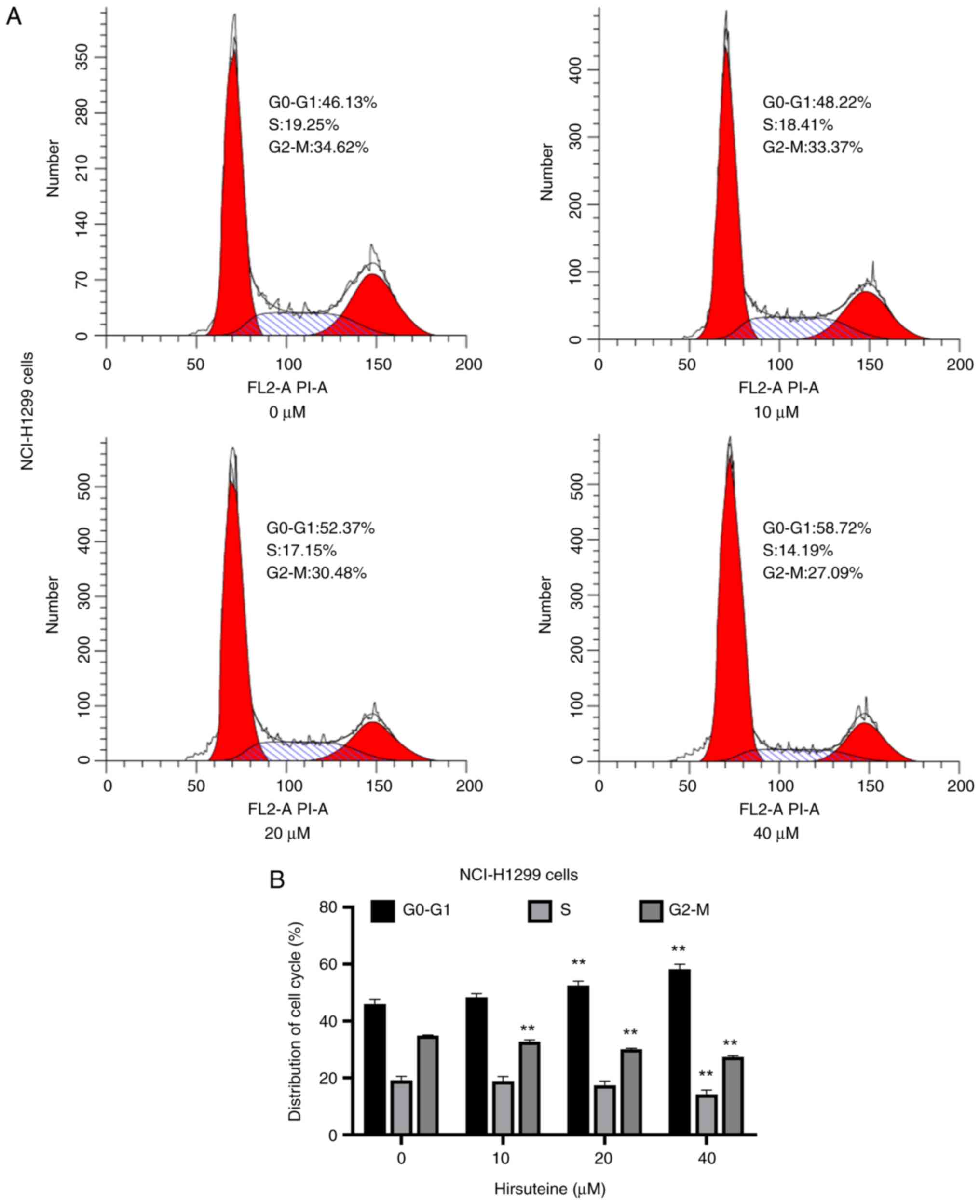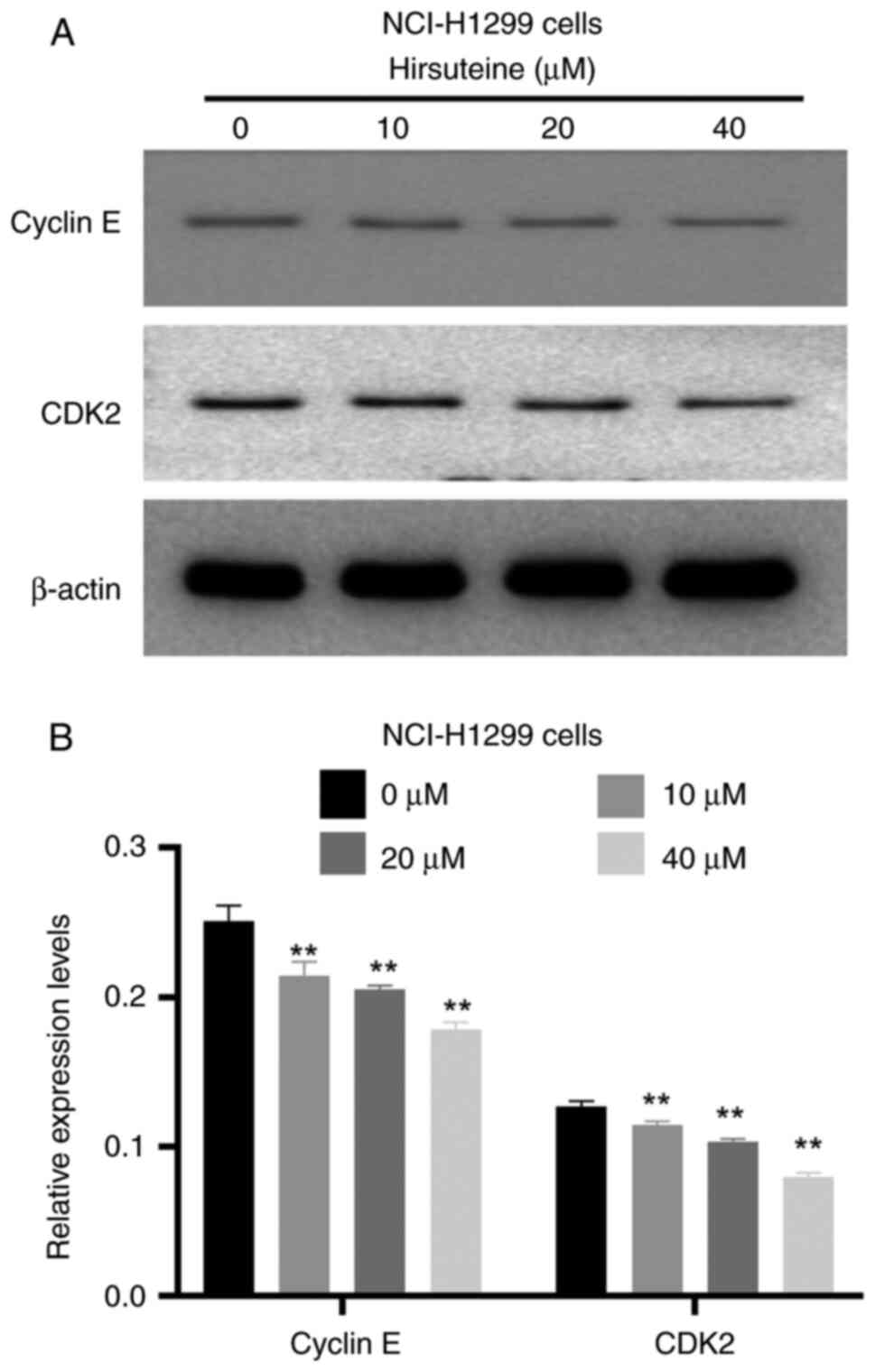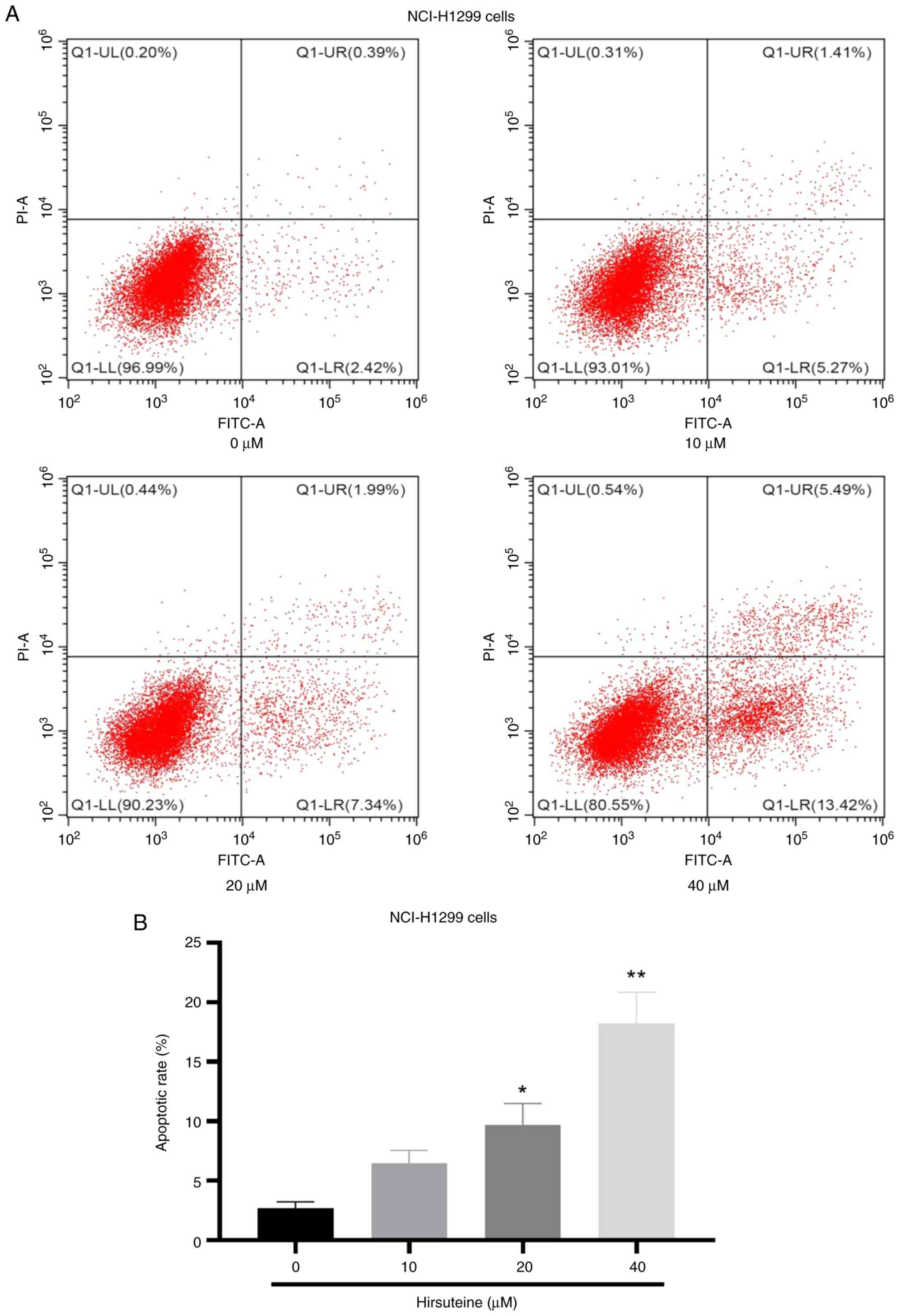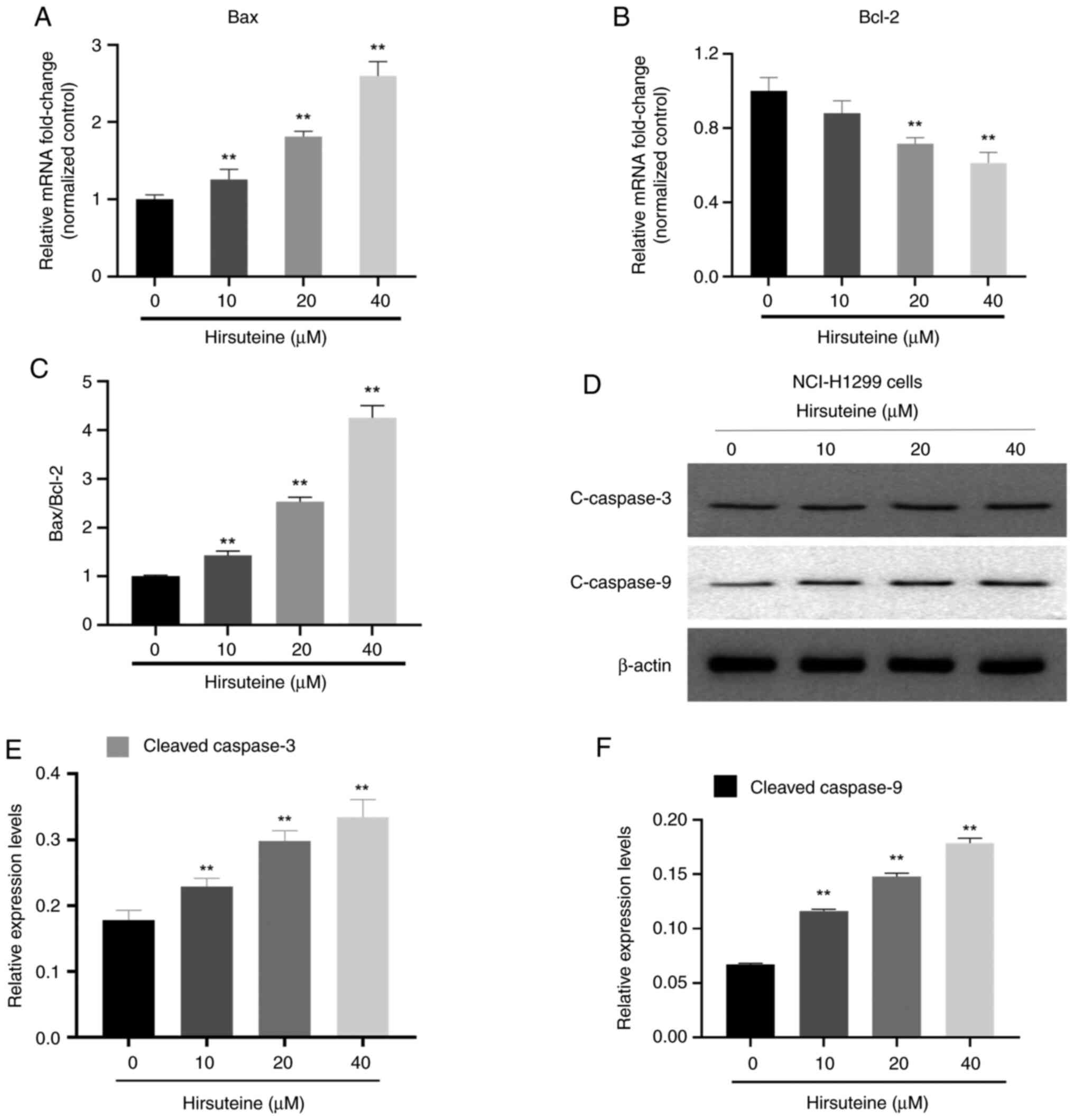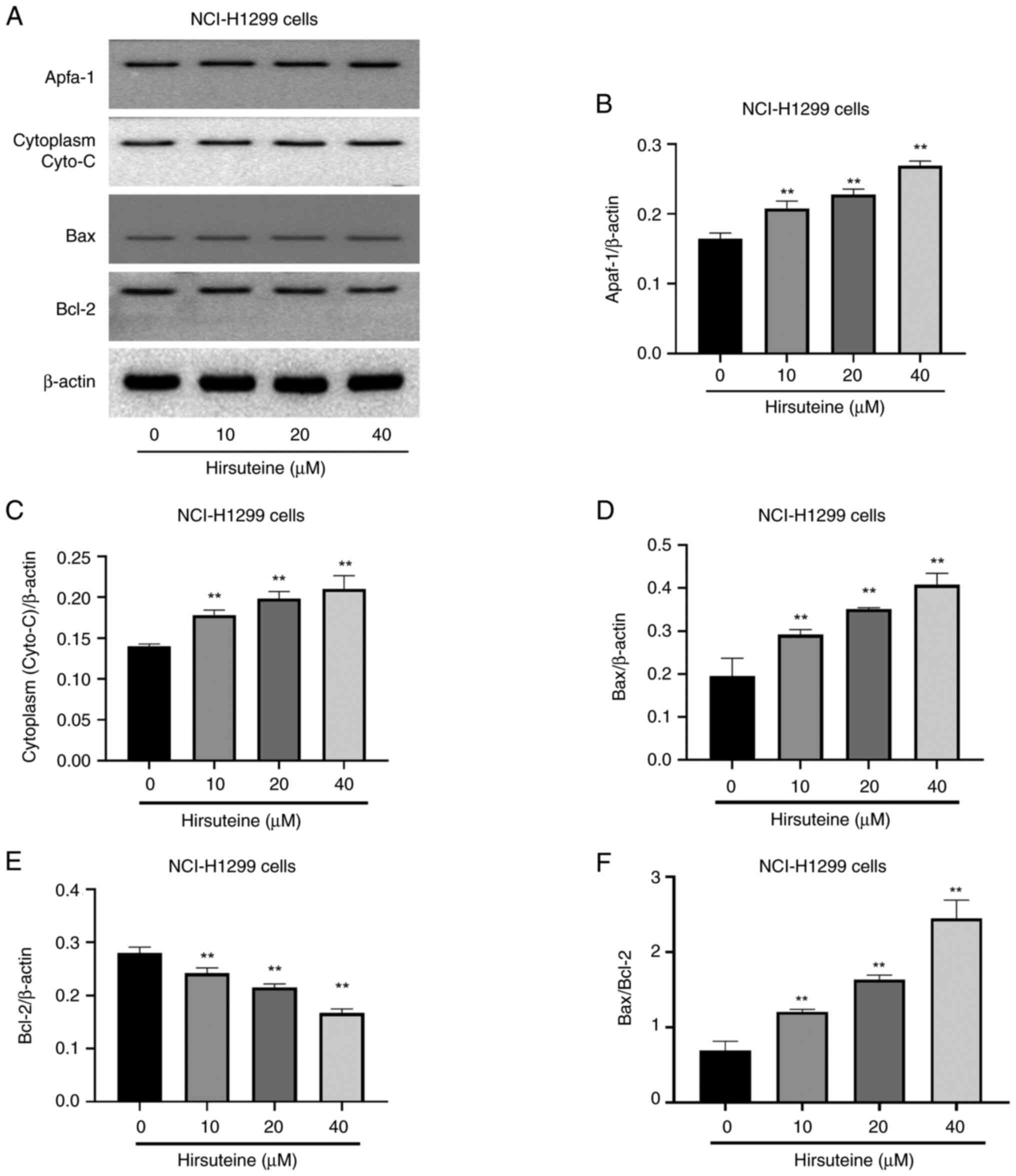|
1
|
Torre LA, Siegel RL and Jemal A: Lung
cancer statistics. Adv Exp Med Biol. 893:1–19. 2016. View Article : Google Scholar : PubMed/NCBI
|
|
2
|
Duma N, Santana-Davila R and Molina JR:
Non-small cell lung cancer: Epidemiology, screening, diagnosis, and
treatment. Mayo Clin Proc. 94:1623–1640. 2019. View Article : Google Scholar : PubMed/NCBI
|
|
3
|
Brueckl WM, Achenbach HJ, Ficker JH and
Schuette W: Erlotinib treatment after platinum-based therapy in
elderly patients with non-small-cell lung cancer in routine
clinical practice-results from the ElderTac study. BMC Cancer.
18:3332018. View Article : Google Scholar : PubMed/NCBI
|
|
4
|
Hirsch FR, Sequist LV, Gore I, Mooradian
M, Simon G, Croft EF, DeVincenzo D, Munley J, Stein D, Freivogel K,
et al: Long-term safety and survival with gefitinib in select
patients with advanced non-small cell lung cancer: Results from the
US IRESSA clinical access program (ICAP). Cancer. 124:2407–2414.
2018. View Article : Google Scholar : PubMed/NCBI
|
|
5
|
Ciuleanu T, Stelmakh L, Cicenas S,
Miliauskas S, Grigorescu AC, Hillenbach C, Johannsdottir HK,
Klughammer B and Gonzalez EE: Efficacy and safety of erlotinib
versus chemotherapy in second-line treatment of patients with
advanced, non-small-cell lung cancer with poor prognosis (TITAN): A
randomised multicentre, open-label, phase 3 study. Lancet Oncol.
13:300–308. 2012. View Article : Google Scholar : PubMed/NCBI
|
|
6
|
Olszewski AJ, Ali S and Witherby SM:
Disparate survival trends in histologic subtypes of metastatic
non-small cell lung cancer: A population-based analysis. Am J
Cancer Res. 5:2229–2240. 2015.PubMed/NCBI
|
|
7
|
Chang JS, Chen LT, Shan YS, Lin SF, Hsiao
SY, Tsai CR, Yu SJ and Tsai HJ: Comprehensive analysis of the
incidence and survival patterns of lung cancer by histologies,
including rare subtypes, in the era of molecular medicine and
targeted therapy: A nation-wide cancer registry-based study from
Taiwan. Medicine (Baltimore). 94:e9692015. View Article : Google Scholar : PubMed/NCBI
|
|
8
|
Jonna S and Subramaniam DS: Molecular
diagnostics and targeted therapies in non-small cell lung cancer
(NSCLC): An update. Discov Med. 27:167–170. 2019.PubMed/NCBI
|
|
9
|
Herbst RS, Morgensztern D and Boshoff C:
The biology and management of non-small cell lung cancer. Nature.
553:446–454. 2018. View Article : Google Scholar : PubMed/NCBI
|
|
10
|
Wolchok JD: PD-1 blockers. Cell.
162:9372015. View Article : Google Scholar : PubMed/NCBI
|
|
11
|
Johnson DB, Sullivan RJ and Menzies AM:
Immune checkpoint inhibitors in challenging populations. Cancer.
123:1904–1911. 2017. View Article : Google Scholar : PubMed/NCBI
|
|
12
|
Ma K, Jin Q, Wang M, Li X and Zhang Y:
Research progress and clinical application of predictive biomarker
for immune checkpoint inhibitors. Expert Rev Mol Diagn. 19:517–529.
2019. View Article : Google Scholar : PubMed/NCBI
|
|
13
|
de Miguel M and Calvo E: Clinical
challenges of immune checkpoint inhibitors. Cancer Cell.
38:326–333. 2020. View Article : Google Scholar : PubMed/NCBI
|
|
14
|
Bando Y, Furukawa J, Terakawa T, Harada K,
Hinata N, Nakano Y and Fujisawa M: Treatment outcomes of molecular
targeted therapy following nivolumab in metastatic renal cell
carcinoma. Jpn J Clin Oncol. 51:1313–1318. 2021. View Article : Google Scholar : PubMed/NCBI
|
|
15
|
Zhang J, Xu D, Zhou Y, Zhu Z and Yang X:
Mechanisms and implications of CDK4/6 inhibitors for the treatment
of NSCLC. Front Oncol. 11:6760412021. View Article : Google Scholar : PubMed/NCBI
|
|
16
|
Koehn FE and Carter GT: The evolving role
of natural products in drug discovery. Nat Rev Drug Discov.
4:206–220. 2005. View
Article : Google Scholar : PubMed/NCBI
|
|
17
|
Horie S, Yano S, Aimi N, Sakai S and
Watanabe K: Effects of hirsutine, an antihypertensive indole
alkaloid from Uncaria rhynchophylla, on intracellular
calcium in rat thoracic aorta. Life Sci. 50:491–498. 1992.
View Article : Google Scholar : PubMed/NCBI
|
|
18
|
Ndagijimana A, Wang X, Pan G, Zhang F,
Feng H and Olaleye O: A review on indole alkaloids isolated from
Uncaria rhynchophylla and their pharmacological studies.
Fitoterapia. 86:35–47. 2013. View Article : Google Scholar : PubMed/NCBI
|
|
19
|
Nakazawa T, Banba K, Hata K, Nihei Y,
Hoshikawa A and Ohsawa K: Metabolites of hirsuteine and hirsutine,
the major indole alkaloids of Uncaria rhynchophylla, in
rats. Biol Pharm Bull. 29:1671–1677. 2006. View Article : Google Scholar : PubMed/NCBI
|
|
20
|
Xian YF, Lin ZX, Mao QQ, Hu Z, Zhao M, Che
CT and Ip SP: Bioassay-guided isolation of neuroprotective
compounds from Uncaria rhynchophylla against
beta-amyloid-induced neurotoxicity. Evid Based Complement Alternat
Med. 2012:8026252012. View Article : Google Scholar : PubMed/NCBI
|
|
21
|
Lan YL, Zhou JJ, Liu J, Huo XK, Wang YL,
Liang JH, Zhao JC, Sun CP, Yu ZL, Fang LL, et al: Uncaria
rhynchophylla ameliorates Parkinson's disease by inhibiting
HSP90 expression: Insights from quantitative proteomics. Cell
Physiol Biochem. 47:1453–1464. 2018. View Article : Google Scholar : PubMed/NCBI
|
|
22
|
Liu CH, Lin YW, Tang NY, Liu HJ and Hsieh
CL: Neuroprotective effect of Uncaria rhynchophylla in
kainic acid-induced epileptic seizures by modulating hippocampal
mossy fiber sprouting, neuron survival, astrocyte proliferation,
and S100B expression. Evid Based Complement Alternat Med.
2012:1947902012.PubMed/NCBI
|
|
23
|
Ozaki Y: Pharmacological studies of indole
alkaloids obtained from domestic plants, Uncaria
rhynchophylla Miq. and Amsonia elliptica Roem. et Schult. Nihon
Yakurigaku Zasshi. 94:17–26. 1989.(In Japanese). View Article : Google Scholar : PubMed/NCBI
|
|
24
|
Ozaki Y: Vasodilative effects of indole
alkaloids obtained from domestic plants, Uncaria
rhynchophylla Miq. and Amsonia elliptica Roem. et Schult. Nihon
Yakurigaku Zasshi. 95:47–54. 1990.(In Japanese). View Article : Google Scholar : PubMed/NCBI
|
|
25
|
Yuzurihara M, Ikarashi Y, Goto K,
Sakakibara I, Hayakawa T and Sasaki H: Geissoschizine methyl ether,
an indole alkaloid extracted from Uncariae Ramulus et Uncus, is a
potent vasorelaxant of isolated rat aorta. Eur J Pharmacol.
444:183–189. 2002. View Article : Google Scholar : PubMed/NCBI
|
|
26
|
Nakamura Y, Ishida Y, Kondo M and Shimada
S: Yokukansan contains compounds that antagonize the
5-HT3 receptor. Phytomedicine. 43:120–125. 2018.
View Article : Google Scholar : PubMed/NCBI
|
|
27
|
Mimaki Y, Toshimizu N, Yamada K and
Sashida Y: Anti-convulsion effects of choto-san and chotoko
(Uncariae Uncis cam Ramlus) in mice, and identification of the
active principles. Yakugaku Zasshi. 117:1011–1021. 1997.(In
Japanese). View Article : Google Scholar : PubMed/NCBI
|
|
28
|
Wang M, Guo J, Wang Z, Zhang G, Yu H,
Chang R and Chen A: Simultaneous separation and determination of
hirsutine and hirsuteine by cyclodextrin-modified micellar
electrokinetic capillary chromatography. Phytochem Anal.
31:112–118. 2020. View
Article : Google Scholar : PubMed/NCBI
|
|
29
|
Huang BY, Zeng Y, Li YJ, Huang XJ, Hu N,
Yao N, Chen MF, Yang ZG, Chen ZS, Zhang DM and Zeng CQ:
Uncaria alkaloids reverse ABCB1-mediated cancer multidrug
resistance. Int J Oncol. 51:257–268. 2017. View Article : Google Scholar : PubMed/NCBI
|
|
30
|
Shimada Y, Goto H, Itoh T, Sakakibara I,
Kubo M, Sasaki H and Terasawa SK: Evaluation of the protective
effects of alkaloids isolated from the hooks and stems of
Uncaria sinensis on glutamate-induced neuronal death in
cultured cerebellar granule cells from rats. J Pharm Pharmacol.
51:715–722. 1999. View Article : Google Scholar : PubMed/NCBI
|
|
31
|
Kawakami Z, Kanno H, Ikarashi Y and Kase
Y: Yokukansan, a kampo medicine, protects against glutamate
cytotoxicity due to oxidative stress in PC12 cells. J
Ethnopharmacol. 134:74–81. 2011. View Article : Google Scholar : PubMed/NCBI
|
|
32
|
Meng J, Su R, Wang L, Yuan B and Li L:
Inhibitory effect and mechanism of action (MOA) of hirsutine on the
proliferation of T-cell leukemia Jurkat clone E6-1 cells. PeerJ.
9:e106922021. View Article : Google Scholar : PubMed/NCBI
|
|
33
|
Livak KJ and Schmittgen TD: Analysis of
relative gene expression data using real-time quantitative PCR and
the 2(−Delta Delta C(T)) method. Methods. 25:402–408. 2001.
View Article : Google Scholar : PubMed/NCBI
|
|
34
|
Zhang R, Li G, Zhang Q, Tang Q, Huang J,
Hu C, Liu Y, Wang Q, Liu W, Gao N and Zhou S: Hirsutine induces
mPTP-dependent apoptosis through ROCK1/PTEN/PI3K/GSK3β pathway in
human lung cancer cells. Cell Death Dis. 9:5982018. View Article : Google Scholar : PubMed/NCBI
|
|
35
|
Chen XX, Leung GP, Zhang ZJ, Xiao JB, Lao
LX, Feng F, Mak JC, Wang Y, Sze SC and Zhang KY: Proanthocyanidins
from Uncaria rhynchophylla induced apoptosis in MDA-MB-231
breast cancer cells while enhancing cytotoxic effects of
5-fluorouracil. Food Chem Toxicol. 107:248–260. 2017. View Article : Google Scholar : PubMed/NCBI
|
|
36
|
Lee JS, Kim J, Kim BY, Lee HS, Ahn JS and
Chang YS: Inhibition of phospholipase cgamma1 and cancer cell
proliferation by triterpene esters from Uncaria
rhynchophylla. J Nat Prod. 63:753–756. 2000. View Article : Google Scholar : PubMed/NCBI
|
|
37
|
Shim JS, Kim HG, Ju MS, Choi JG, Jeong SY
and Oh MS: Effects of the hook of Uncaria rhynchophylla on
neurotoxicity in the 6-hydroxydopamine model of Parkinson's
disease. J Ethnopharmacol. 126:361–365. 2009. View Article : Google Scholar : PubMed/NCBI
|
|
38
|
Wang Y, Ji P, Liu J, Broaddus RR, Xue F
and Zhang W: Centrosome-associated regulators of the G(2)/M
checkpoint as targets for cancer therapy. Mol Cancer. 8:82009.
View Article : Google Scholar : PubMed/NCBI
|
|
39
|
Endicott JA and Noble ME: Structural
principles in cell-cycle control: Beyond the CDKs. Structure.
6:535–541. 1998. View Article : Google Scholar : PubMed/NCBI
|
|
40
|
Coudreuse D and Nurse P: Driving the cell
cycle with a minimal CDK control network. Nature. 468:1074–1079.
2010. View Article : Google Scholar : PubMed/NCBI
|
|
41
|
Harashima H, Dissmeyer N and Schnittger A:
Cell cycle control across the eukaryotic kingdom. Trends Cell Biol.
23:345–356. 2013. View Article : Google Scholar : PubMed/NCBI
|
|
42
|
Cao L, Chen F, Yang X, Xu W, Xie J and Yu
L: Phylogenetic analysis of CDK and cyclin proteins in premetazoan
lineages. BMC Evol Biol. 14:102014. View Article : Google Scholar : PubMed/NCBI
|
|
43
|
Li Z: Regulation of the cell division
cycle in trypanosoma brucei. Eukaryot Cell. 11:1180–1190. 2012.
View Article : Google Scholar : PubMed/NCBI
|
|
44
|
Gutierrez C: The arabidopsis cell division
cycle. Arabidopsis Book. 7:e01202009. View Article : Google Scholar : PubMed/NCBI
|
|
45
|
Qin A, Reddy HG, Weinberg FD and
Kalemkerian GP: Cyclin-dependent kinase inhibitors for the
treatment of lung cancer. Expert Opin Pharmacother. 21:941–952.
2020. View Article : Google Scholar : PubMed/NCBI
|
|
46
|
Otto T and Sicinski P: Cell cycle proteins
as promising targets in cancer therapy. Nat Rev Cancer. 17:93–115.
2017. View Article : Google Scholar : PubMed/NCBI
|
|
47
|
No authors listed. Milestones in cell
division. Nat Cell Biol. 3:E2652001. View Article : Google Scholar : PubMed/NCBI
|
|
48
|
Fulda S, Gorman AM, Hori O and Samali A:
Cellular stress responses: Cell survival and cell death. Int J Cell
Biol. 2010:2140742010. View Article : Google Scholar : PubMed/NCBI
|
|
49
|
Long S, Wilson M, Bengtén E, Clem LW,
Miller NW and Chinchar VG: Identification and characterization of a
FasL-like protein and cDNAs encoding the channel catfish
death-inducing signaling complex. Immunogenetics. 56:518–530. 2004.
View Article : Google Scholar : PubMed/NCBI
|
|
50
|
Youle RJ and Strasser A: The BCL-2 protein
family: Opposing activities that mediate cell death. Nat Rev Mol
Cell Biol. 9:47–59. 2008. View Article : Google Scholar : PubMed/NCBI
|
|
51
|
Haldar S, Negrini M, Monne M, Sabbioni S
and Croce CM: Down-regulation of bcl-2 by p53 in breast cancer
cells. Cancer Res. 54:2095–2097. 1994.PubMed/NCBI
|
|
52
|
Hwang KT, Han W, Kim J, Moon HG, Oh S,
Song YS, Kim YA, Chang MS and Noh DY: Prognostic influence of BCL2
on molecular subtypes of breast cancer. J Breast Cancer. 20:54–64.
2017. View Article : Google Scholar : PubMed/NCBI
|
|
53
|
Jamous A and Salah Z: WW-domain containing
protein roles in breast tumorigenesis. Front Oncol. 8:5802018.
View Article : Google Scholar : PubMed/NCBI
|
|
54
|
Jensen K, WuWong DJ, Wong S, Matsuyama M
and Matsuyama S: Pharmacological inhibition of Bax-induced cell
death: Bax-inhibiting peptides and small compounds inhibiting Bax.
Exp Biol Med (Maywood). 244:621–329. 2019. View Article : Google Scholar : PubMed/NCBI
|
|
55
|
Nemec KN and Khaled AR: Therapeutic
modulation of apoptosis: Targeting the BCL-2 family at the
interface of the mitochondrial membrane. Yonsei Med J. 49:689–697.
2008. View Article : Google Scholar : PubMed/NCBI
|
|
56
|
Chresta CM, Masters JR and Hickman JA:
Hypersensitivity of human testicular tumors to etoposide-induced
apoptosis is associated with functional p53 and a high Bax: Bcl-2
ratio. Cancer Res. 56:1834–1841. 1996.PubMed/NCBI
|
|
57
|
Strasser A, Cory S and Adams JM:
Deciphering the rules of programmed cell death to improve therapy
of cancer and other diseases. EMBO J. 30:3667–3683. 2011.
View Article : Google Scholar : PubMed/NCBI
|
|
58
|
Jiang X and Wang X: Cytochrome C-mediated
apoptosis. Annu Rev Biochem. 73:87–106. 2004. View Article : Google Scholar : PubMed/NCBI
|
|
59
|
Eskes R, Antonsson B, Osen-Sand A,
Montessuit S, Richter C, Sadoul R, Mazzei G, Nichols A and Martinou
JC: Bax-induced cytochrome C release from mitochondria is
independent of the permeability transition pore but highly
dependent on Mg2+ ions. J Cell Biol. 143:217–224. 1998. View Article : Google Scholar : PubMed/NCBI
|
|
60
|
Lee CH, Shih YL, Lee MH, Au MK, Chen YL,
Lu HF and Chung JG: Bufalin induces apoptosis of human osteosarcoma
U-2 OS cells through endoplasmic reticulum stress, caspase- and
mitochondria-dependent signaling pathways. Molecules. 22:4372017.
View Article : Google Scholar : PubMed/NCBI
|
|
61
|
Monie TP and Bryant CE: Caspase-8
functions as a key mediator of inflammation and pro-IL-1β
processing via both canonical and non-canonical pathways. Immunol
Rev. 265:181–193. 2015. View Article : Google Scholar : PubMed/NCBI
|
|
62
|
Vaculova A and Zhivotovsky B: Caspases:
Determination of their activities in apoptotic cells. Methods
Enzymol. 442:157–181. 2008. View Article : Google Scholar : PubMed/NCBI
|
|
63
|
He Y, Chen W, Hu Y, Luo B, Wu L, Qiao Y,
Mo Q, Xu R, Zhou Y, Ren Z, et al: E. adenophorum induces cell cycle
and apoptosis of renal cells through mitochondrial pathway and
caspase activation in saanen goat. PLoS One. 10:e01385042015.
View Article : Google Scholar : PubMed/NCBI
|
|
64
|
He Y, Mo Q, Hu Y, Chen W, Luo B, Wu L,
Qiao Y, Xu R, Zhou Y, Zuo Z, et al: E. adenophorum induces cell
cycle arrest and apoptosis of splenocytes through the mitochondrial
pathway and caspase activation in saanen goats. Sci Rep.
5:159672015. View Article : Google Scholar : PubMed/NCBI
|
|
65
|
He Y, Mo Q, Luo B, Qiao Y, Xu R, Zuo Z,
Deng J, Nong X, Peng G, He W, et al: Induction of apoptosis and
autophagy via mitochondria- and PI3K/Akt/mTOR-mediated pathways by
E. adenophorum in hepatocytes of saanen goat. Oncotarget.
7:54537–54548. 2016. View Article : Google Scholar : PubMed/NCBI
|
|
66
|
Zhou Q, Ma J and Chen L: Tissue
distribution of hirsutine and hirsuteine in mice by
ultrahigh-performance liquid chromatography-mass spectrometry. J
Anal Methods Chem. 2020:72043152020. View Article : Google Scholar : PubMed/NCBI
|















